Tactical shifts: where do the Sens go from here?
How might the Ottawa Senators deploy their line-up to maximize their strengths and minimize their weaknesses?
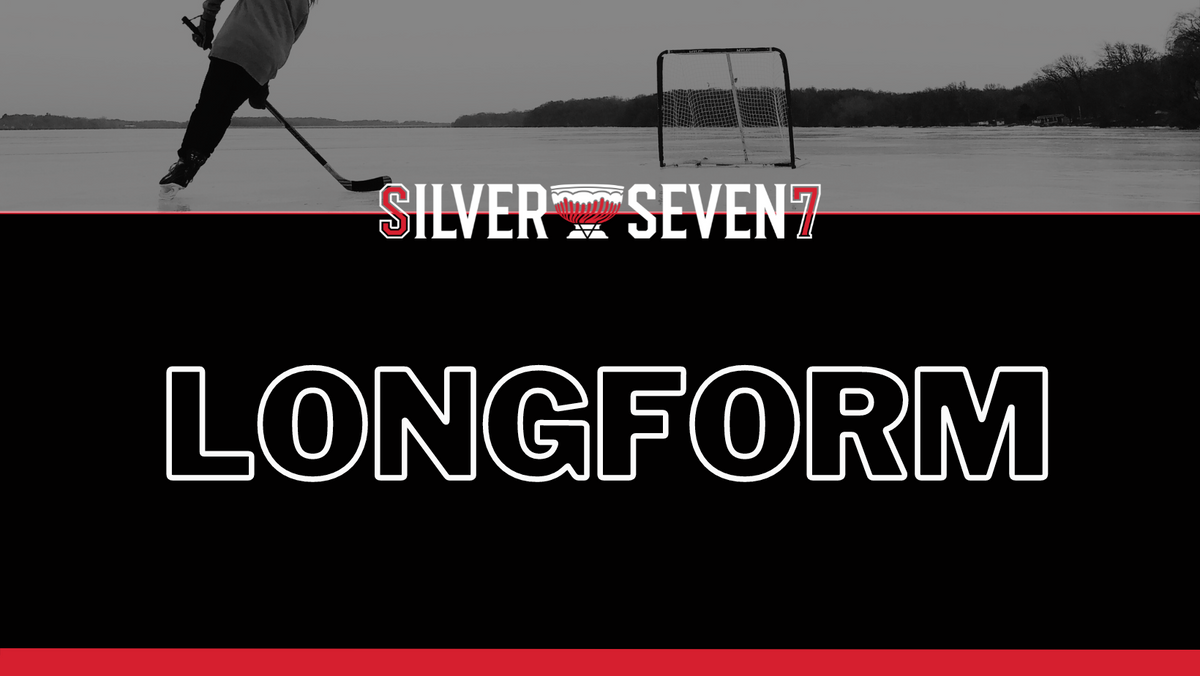
Last week, we took a look at data sourced from Corey Sznajder and Evolving-Hockey to try to ascertain how the Senators have fared, as a team, under D.J. Smith and his coaching staff. We found growth in the team's game, showcasing a balanced, flexible offensive repertoire and an ability to be aggressive when defending the rush last season. We also found weaknesses, namely the team's in-zone defence and poor breakouts to get transition play started.
Speaking to Ian Mendes at the 2023 NHL Draft, D.J. Smith highlighted how it's essential that the group's team play and line combinations are organized heading into training camp so that the team can maximize their start, especially given that 12 of the team's first 17 games are at home.
In this article, we'll take a look at the team's projected personnel for 2023-24 to see, based on the data, if there are certain combinations of players that the team should consider.
Let's start by reminding ourselves of the players who have arrived and departed at this point in the offseason. In terms of isolated impact on shot rates, the team's shedding of Nikita Zaitsev, Dylan Gambrell, Austin Watson, Jake Lucchini, Derick Brassard, Nick Holden, Tyler Motte, Julien Gauthier, and Patrick Brown alleviates some of the offensive drag on the squad, while losing Alex DeBrincat subtracts some offensive impact that didn't quite make up for defensive deficiencies while he was on the ice. Gambrell, Brassard, Holden, Motte, and Gauthier were either neutral or harmful defensively as well.

In their place are Vladimir Tarasenko, Dominik Kubalik, Zack MacEwen, Jiri Smejkal, Matthew Highmore, Bokondji Imama, Josh Currie, and Garret Pilon.
The Data
- Brady Tkachuk was stapled to the wing of Tim Stützle last season and, despite Josh Norris' return, it's hard to see this changing too much. Tkachuk and Stützle drove more offence for the team in 2022-23 than any other combination of winger and centre. As you can see in Sznjader's data, the two complement each other so well – Stützle helping to mask Tkachuk's skating deficiencies in transition (entries, exits), and Tkachuk returning the favour by being first-in on the forecheck and effectively recovering the puck. A useful third player is likely someone with a balanced offensive toolkit who can either be on the receiving end of all the offensive these two create – waiting quietly in soft areas of the ice – or a winger with the skating to support Stützle in transition and Tkachuk on the forecheck.
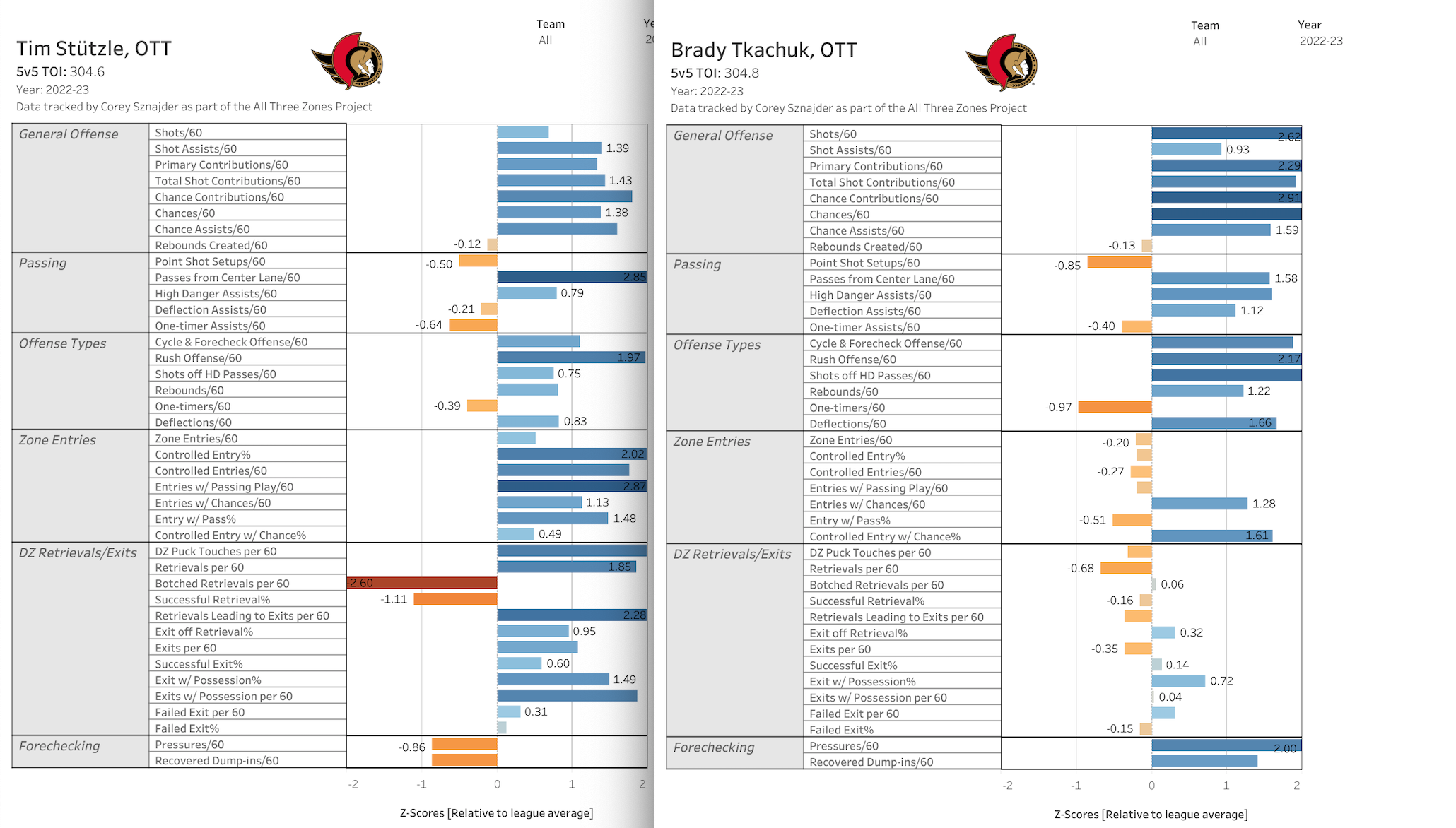
- Before we figure out who should start at right-wing on that line – you could anoint Claude Giroux after their success last season – we should take a look at the rest of the top-nine, because there are many new faces. Swapping DeBrincat for Tarasenko and Kubalik represent a marked change in skillsets outside of their shooting similarities, and the return of Josh Norris means that the second line will have a brand new feel. We don't have data on Norris' 2022-23 season for obvious reasons, but his player card for 2021-22 show a player who, like most, is in need of help. As we noted in last week's piece, Ottawa has systemic issues on retrievals and exits; a süperstar like Stützle is able to bypass these issues because of his puck carrying ability, but most other centres on the team will need wingers who can be available on zone exits. Based on the data, it looks like Norris was able to retrieve the puck in the defensive zone, but struggled to transition it up the ice. A winger with a high motor who's available to receive a pass and then has the toolkit to drive a zone entry themselves would be helpful. Once this line is in the offensive zone, it's more likely that Norris might naturally see upticks in his shooting contributions given his skillset, but could be supported by another winger who has strong passing ability.
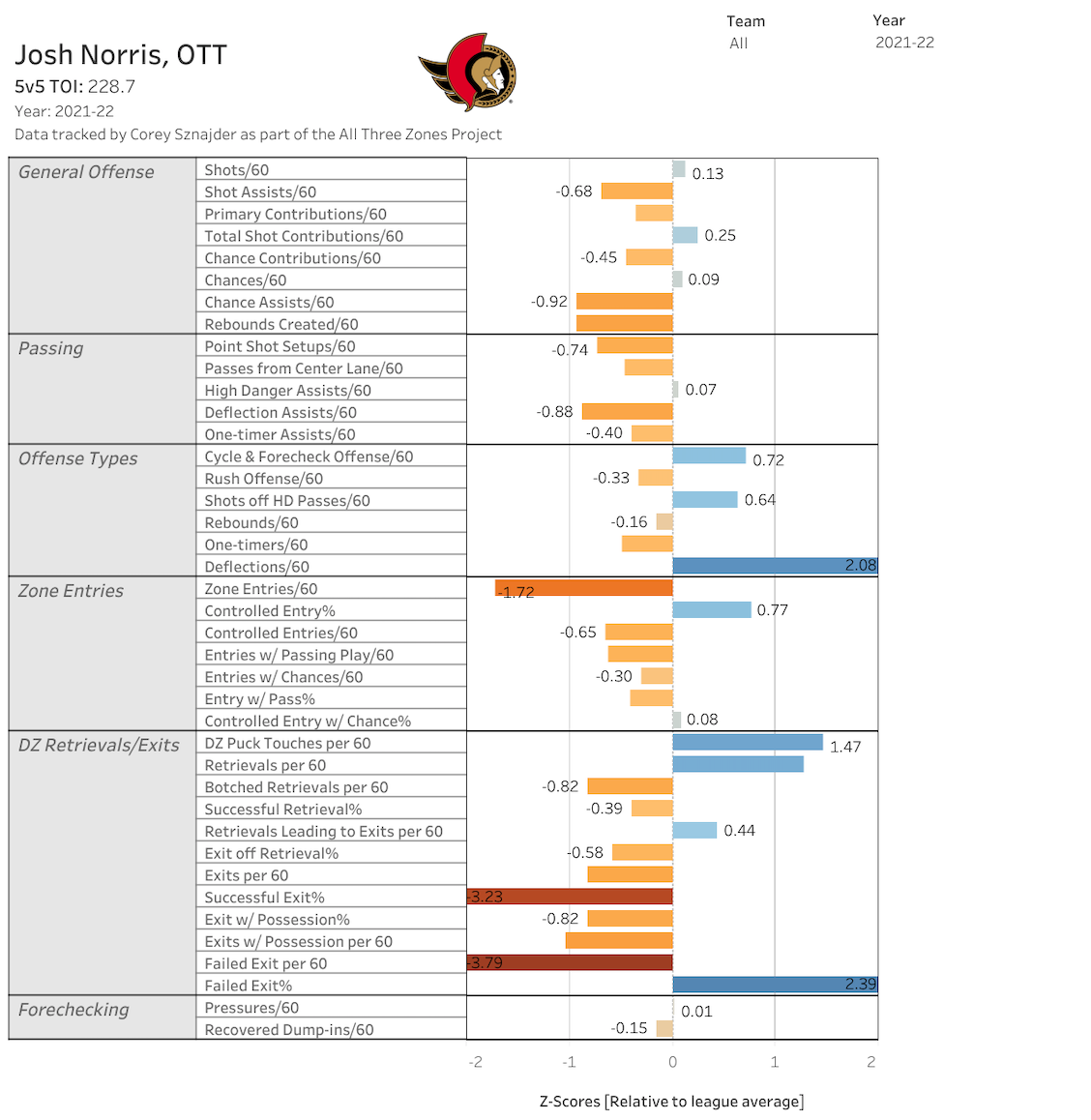
- Let's round out the pivots by looking at Shane Pinto – a player who performed well given the circumstances on the second line, and might get some matchup benefits on the third-line. Pinto was ever-reliable in the defensive zone, coming low to retrieve the puck and often working to carry the puck out with strong puck protection ability. Offensively, however, the micro-stats don't paint quite as pretty a picture. When he ran into a wall in the neutral zone, he struggled to find passing options, so his offence largely consisted of chipping it into the offensive zone, pressuring the defence but usually coming up unsuccessful in recovering the puck, and ending up right back on defence. Given this, Pinto might benefit from either: wingers who could retrieve the puck if he becomes more adept at placing his chips more strategically and/or wingers who he could defer to once in the neutral zone via a short pass to get around the neutral zone trap and rely on for a controlled entry.
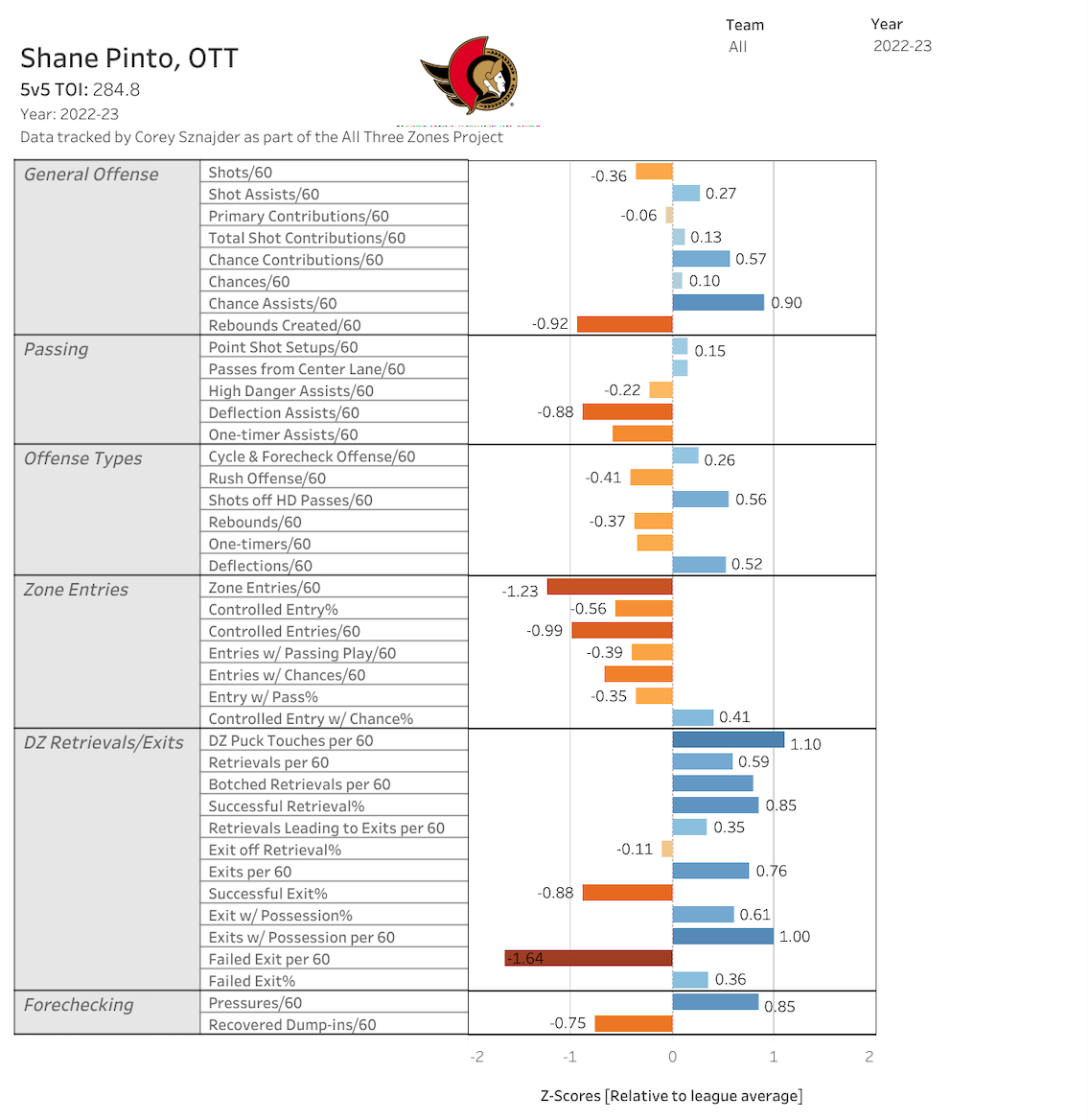
Given all of this, let's take a look at four wingers and see if any played the role we want them to try and play in 2023-24.
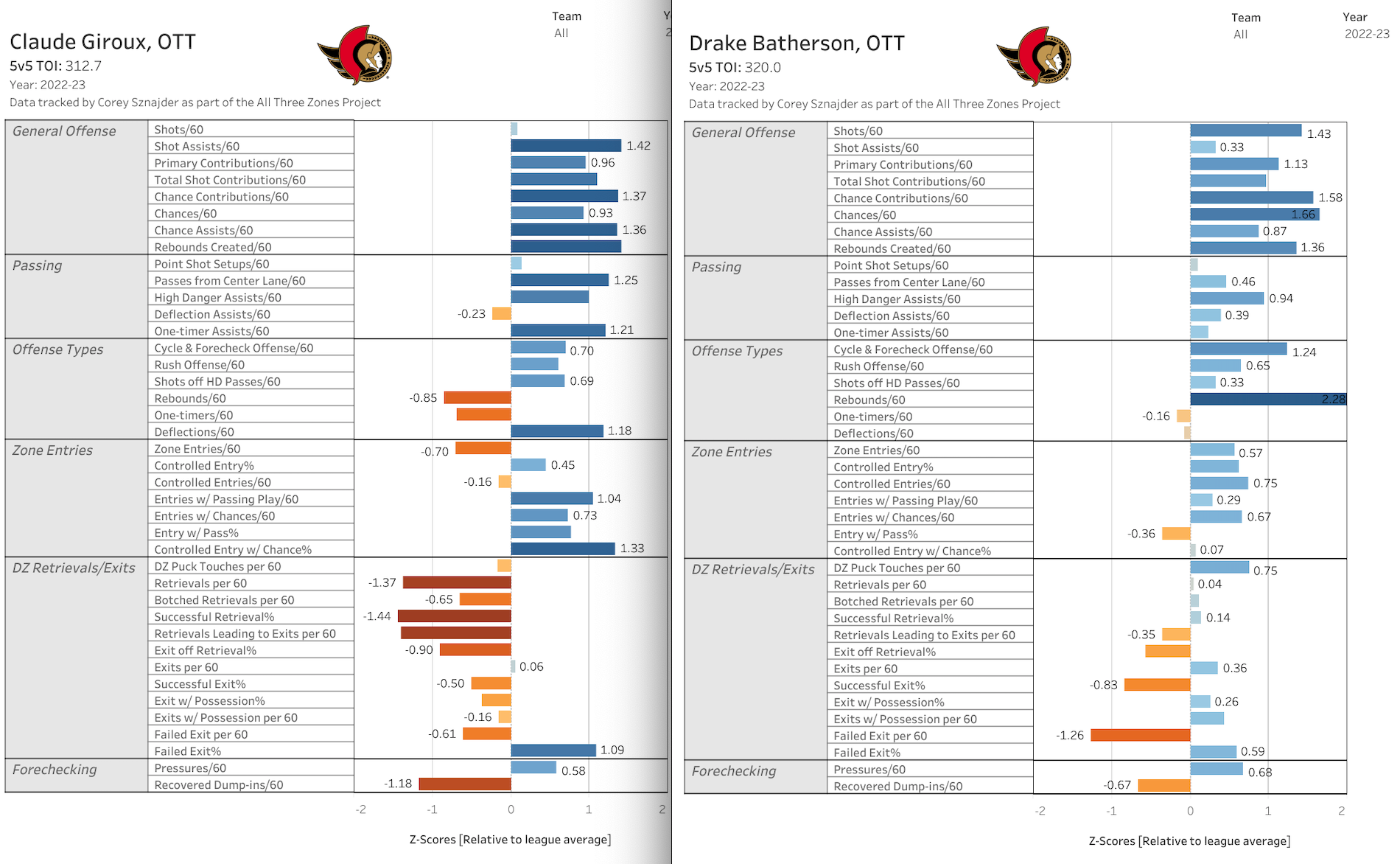
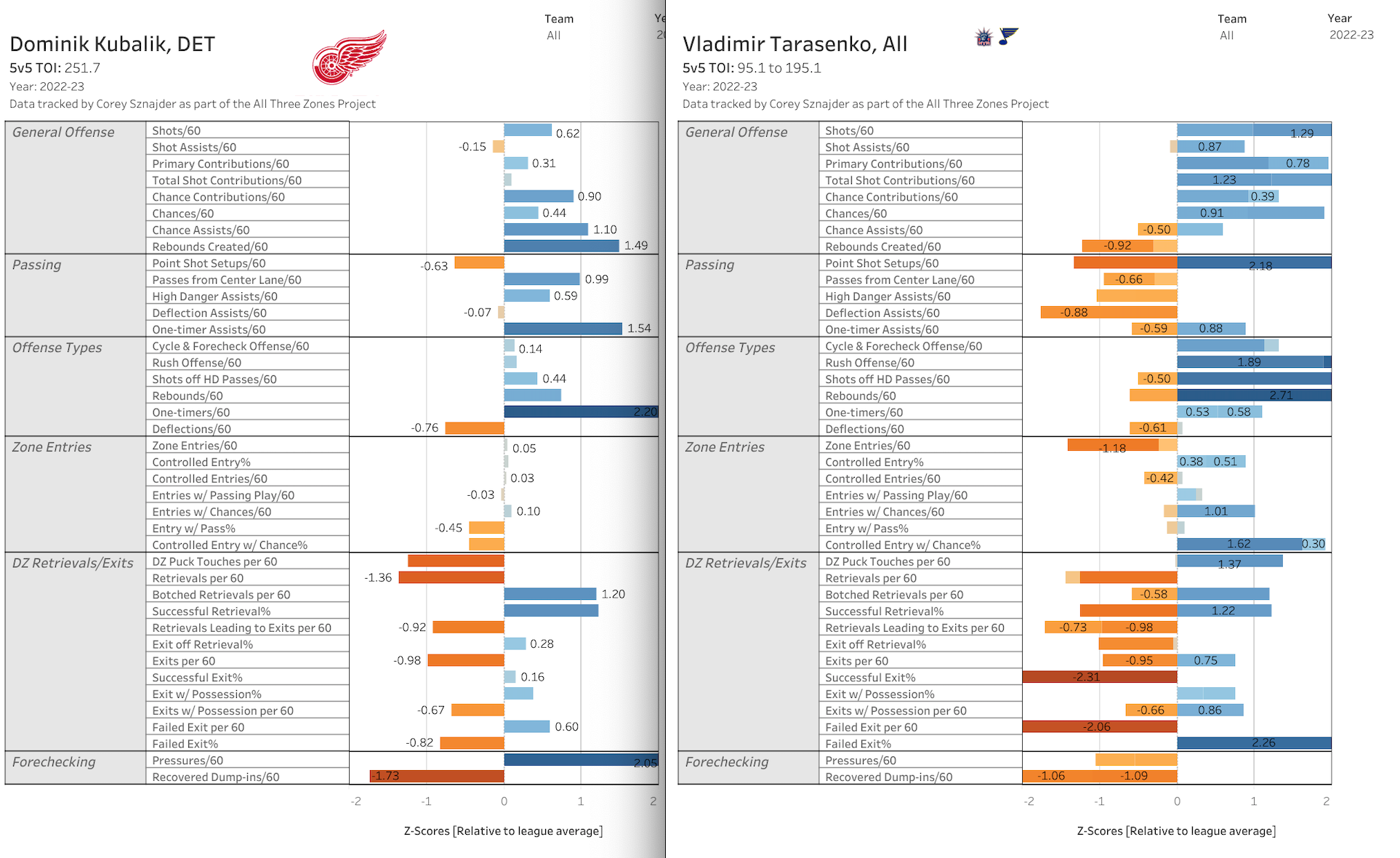
- The oldies, Giroux and Tarasenko, had similar microstat tracking results last season. Both are still able to showcase their high-end skill inside the offensive zone, but with different strengths: Giroux's in-zone and transition passing ability remains strong while Tarasenko was able to contribute off the rush, get into high-danger areas to receive passes, and be around the net for rebounds.
- Dominik Kubalik has dual-threat ability as a shooter and a passer, and loves to get open for one-timer opportunities. He's balanced on zone entries, and pressured the puck carrier as a forechecker.
- Drake Batherson is the team's most balanced winger and of these four, is the most likely to continue growing in his game. His propensity for individually securing more zone entries than the players we're comparing him to here will be helpful in slotting him in appropriately.
Ultimately, here's where I stand: I'd be curious to try Tarasenko with Tkachuk and Stützle – two superstars who can make up for his flaws in transition – or alongside Claude Giroux with Josh Norris. It's worth noting that Stützle is Ottawa's closest player stylistically to Blues forward Robert Thomas, the player Tarasenko had a re-emergence with in 2021-22. While it's great to know that you can throw Giroux onto the top line to load them up when you need a goal, Giroux's skillset on zone entries and as an in-zone passer might be best suited helping Norris or Pinto at 5-on-5. Meanwhile, if you're spreading ice-time across your top-nine instead of loading up your top-six, I'd argue that playing Batherson with Pinto might help the young centre extend his offensive sequences the most and potentially get more open to unleash his shot. Kubalik has the skillset of a complementary winger that can go with Norris or Pinto, and it might depend on the wildcard of the forward group – Ridly Greig, whom we have no tracking data on – to see where he's best suited. Throughout his junior career and in Belleville, Greig has been known for his energy on the forecheck and his passing ability; he's played centre a lot, but is likely a winger on the current iteration of the Senators.
I'd attempt to give the following triads a shot at camp: Stützle with Tkachuk and Tarasenko; Norris with Greig and Giroux; Pinto with Kubalik and Batherson. Do you agree? Disagree? Let's discuss in the comments!
A final piece that stood out when looking at the data is that, systemically, all of team's wingers have not played a strong role in the defensive zone to support with retrievals or exits. That's likely because most NHL teams utilize systems where defenders and centres are in that role, but it still makes me wonder about ways the coaching staff can support their wingers in being more effective in this area. Nathan Ni and Jack Han wrote two illuminating pieces on this, but to paraphrase, some key questions I'll be looking for at training camp are:
- In the defensive zone, are players trying to get to the inside with the puck or are they just looking to get it out in any way possible? Supporting the centre by skating your routes and making quick passes to beat the initial wall your own blueline will be important.
- In the neutral zone, are players looking to build up speed behind the puck? If they're shooting it into the offensive zone without speed, they'll likely continue the pattern of pressure without retrieval or will be over-relying on players with one-on-one ability – Stützle, Giroux, Batherson – to bear the burden on entries again.
- In the offensive zone, how much patience do the players have with the puck before sending it on net? The additions of Kubalik and Tarasenko mean that the team has multiple shooters available on all three lines. Scanning appropriately (i.e., keeping your head on a swivel) will be extra important to make sure the best options are found for high-danger opportunities.
Thank you for reading!



